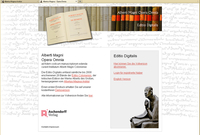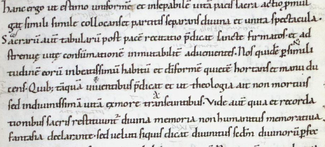Below is an excerpt from Benedict XVI’s appreciative and enthusiastic commendation of St. Albert’s manifold accomplishments in philosophy, theology, and science. These comments were delivered at the General Audience held on March 24th, 2010.
….
He still has a lot to teach us. Above all, St Albert shows that there is no opposition between faith and science, despite certain episodes of misunderstanding that have been recorded in history. A man of faith and prayer, as was St Albert the Great, can serenely foster the study of the natural sciences and progress in knowledge of the micro- and macrocosm, discovering the laws proper to the subject, since all this contributes to fostering thirst for and love of God. The Bible speaks to us of creation as of the first language through which God who is supreme intelligence, who is the Logos reveals to us something of himself. The Book of Wisdom, for example, says that the phenomena of nature, endowed with greatness and beauty, is like the works of an artist through which, by analogy, we may know the Author of creation (cf. Wis 13: 5). With a classical similitude in the Middle Ages and in the Renaissance one can compare the natural world to a book written by God that we read according to the different approaches of the sciences (cf. Address to the participants in the Plenary Meeting of the Pontifical Academy of Sciences, 31 October 2008; L’Osservatore Romano English edition, 5 November 2008, p. 6). How many scientists, in fact, in the wake of St Albert the Great, have carried on their research inspired by wonder at and gratitude for a world which, to their eyes as scholars and believers, appeared and appears as the good work of a wise and loving Creator! Scientific study is then transformed into a hymn of praise. Enrico Medi, a great astrophysicist of our time, whose cause of beatification has been introduced, wrote: “O you mysterious galaxies… I see you, I calculate you, I understand you, I study you and I discover you, I penetrate you and I gather you. From you I take light and make it knowledge, I take movement and make it wisdom, I take sparkling colours and make them poetry; I take you stars in my hands and, trembling in the oneness of my being, I raise you above yourselves and offer you in prayer to the Creator, that through me alone you stars can worship” (Le Opere. Inno alla creazione).
St Albert the Great reminds us that there is friendship between science and faith and that through their vocation to the study of nature, scientists can take an authentic and fascinating path of holiness.
His extraordinary openmindedness is also revealed in a cultural feat which he carried out successfully, that is, the acceptance and appreciation of Aristotle’s thought. In St Albert’s time, in fact, knowledge was spreading of numerous works by this great Greek philosopher, who lived a quarter of a century before Christ, especially in the sphere of ethics and metaphysics. They showed the power of reason, explained lucidly and clearly the meaning and structure of reality, its intelligibility and the value and purpose of human actions. St Albert the Great opened the door to the complete acceptance in medieval philosophy and theology of Aristotle’s philosophy, which was subsequently given a definitive form by St Thomas. This reception of a pagan pre-Christian philosophy, let us say, was an authentic cultural revolution in that epoch. Yet many Christian thinkers feared Aristotle’s philosophy, a non-Christian philosophy, especially because, presented by his Arab commentators, it had been interpreted in such a way, at least in certain points, as to appear completely irreconcilable with the Christian faith. Hence a dilemma arose: are faith and reason in conflict with each other or not?
This is one of the great merits of St Albert: with scientific rigour he studied Aristotle’s works, convinced that all that is truly rational is compatible with the faith revealed in the Sacred Scriptures. In other words, St Albert the Great thus contributed to the formation of an autonomous philosophy, distinct from theology and united with it only by the unity of the truth. So it was that in the 13th century a clear distinction came into being between these two branches of knowledge, philosophy and theology, which, in conversing with each other, cooperate harmoniously in the discovery of the authentic vocation of man, thirsting for truth and happiness: and it is above all theology, that St Albert defined as “emotional knowledge”, which points out to human beings their vocation to eternal joy, a joy that flows from full adherence to the truth.
St Albert the Great was capable of communicating these concepts in a simple and understandable way. An authentic son of St Dominic, he willingly preached to the People of God, who were won over by his words and by the example of his life.
Dear brothers and sisters, let us pray the Lord that learned theologians will never be lacking in holy Church, wise and devout like St Albert the Great, and that he may help each one of us to make our own the “formula of holiness” that he followed in his life: “to desire all that I desire for the glory of God, as God desires for his glory all that he desires”, in other words always to be conformed to God’s will, in order to desire and to do everything only and always for his glory.
 The Albertus Magnus Institute in Bonn (Germany), responsible for the critical edition of Saint Albert the Great, has now prepared a digital edition of the 28 volumes which since 1951 have appeared. Here you can download the English-German flyer with detailed information on the use of this digital edition. Free access to a trial version is available here.
The Albertus Magnus Institute in Bonn (Germany), responsible for the critical edition of Saint Albert the Great, has now prepared a digital edition of the 28 volumes which since 1951 have appeared. Here you can download the English-German flyer with detailed information on the use of this digital edition. Free access to a trial version is available here.

